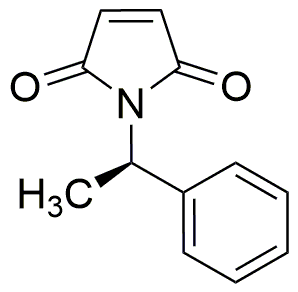(R)-(+)-N-(1-Phenylethyl)maleimide is widely utilized in research focused on
- Organic Synthesis: This compound serves as a versatile intermediate in the synthesis of various organic molecules, particularly in the development of pharmaceuticals and agrochemicals.
- Chiral Catalysis: Its chiral nature makes it an excellent candidate for asymmetric synthesis, allowing researchers to produce enantiomerically pure compounds more efficiently than with non-chiral alternatives.
- Polymer Chemistry: It is used in the formulation of specialty polymers, enhancing properties such as thermal stability and mechanical strength, which are crucial in materials science.
- Bioconjugation: The compound can be employed in bioconjugation techniques, aiding in the development of targeted drug delivery systems and diagnostic tools in the biomedical field.
- Fluorescent Probes: It is also utilized in creating fluorescent probes for biological imaging, providing researchers with valuable tools for studying cellular processes.
General Information
Properties
Safety and Regulations
Applications
(R)-(+)-N-(1-Phenylethyl)maleimide is widely utilized in research focused on
- Organic Synthesis: This compound serves as a versatile intermediate in the synthesis of various organic molecules, particularly in the development of pharmaceuticals and agrochemicals.
- Chiral Catalysis: Its chiral nature makes it an excellent candidate for asymmetric synthesis, allowing researchers to produce enantiomerically pure compounds more efficiently than with non-chiral alternatives.
- Polymer Chemistry: It is used in the formulation of specialty polymers, enhancing properties such as thermal stability and mechanical strength, which are crucial in materials science.
- Bioconjugation: The compound can be employed in bioconjugation techniques, aiding in the development of targeted drug delivery systems and diagnostic tools in the biomedical field.
- Fluorescent Probes: It is also utilized in creating fluorescent probes for biological imaging, providing researchers with valuable tools for studying cellular processes.
Documents
Safety Data Sheets (SDS)
The SDS provides comprehensive safety information on handling, storage, and disposal of the product.
Product Specification (PS)
The PS provides a comprehensive breakdown of the product’s properties, including chemical composition, physical state, purity, and storage requirements. It also details acceptable quality ranges and the product's intended applications.
Certificates of Analysis (COA)
Search for Certificates of Analysis (COA) by entering the products Lot Number. Lot and Batch Numbers can be found on a product’s label following the words ‘Lot’ or ‘Batch’.
*Catalog Number
*Lot Number
Certificates Of Origin (COO)
This COO confirms the country where the product was manufactured, and also details the materials and components used in it and whether it is derived from natural, synthetic, or other specific sources. This certificate may be required for customs, trade, and regulatory compliance.
*Catalog Number
*Lot Number
Safety Data Sheets (SDS)
The SDS provides comprehensive safety information on handling, storage, and disposal of the product.
DownloadProduct Specification (PS)
The PS provides a comprehensive breakdown of the product’s properties, including chemical composition, physical state, purity, and storage requirements. It also details acceptable quality ranges and the product's intended applications.
DownloadCertificates of Analysis (COA)
Search for Certificates of Analysis (COA) by entering the products Lot Number. Lot and Batch Numbers can be found on a product’s label following the words ‘Lot’ or ‘Batch’.
*Catalog Number
*Lot Number
Certificates Of Origin (COO)
This COO confirms the country where the product was manufactured, and also details the materials and components used in it and whether it is derived from natural, synthetic, or other specific sources. This certificate may be required for customs, trade, and regulatory compliance.


